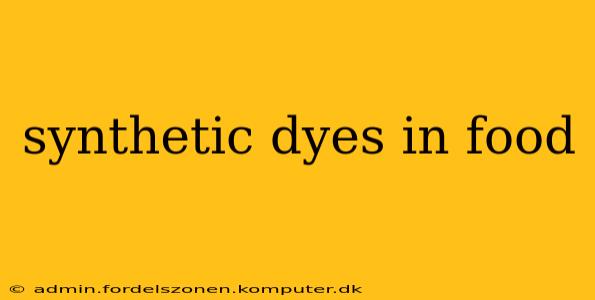Synthetic food dyes are ubiquitous in our modern food supply, adding vibrant hues to everything from candy and soda to yogurt and baked goods. But these artificial colors, while visually appealing, have sparked considerable debate regarding their potential health effects. This comprehensive guide delves into the world of synthetic food dyes, exploring their uses, safety concerns, and alternatives.
What are Synthetic Food Dyes?
Synthetic food dyes are artificial pigments created in laboratories, offering manufacturers a cost-effective and highly saturated way to color their products. Unlike natural food colorings derived from plants or animals, synthetic dyes are chemically synthesized, resulting in consistent and vibrant colors. These dyes are typically petroleum-based and are added to foods to enhance their visual appeal and compensate for color loss during processing. They are categorized and regulated by various international food safety organizations.
Are Synthetic Food Dyes Safe?
This is the central question surrounding synthetic food dyes. Regulatory bodies like the FDA (in the United States) and EFSA (in Europe) have established acceptable daily intakes (ADIs) for approved synthetic dyes, suggesting they are safe at these levels. However, research on long-term effects and individual sensitivities remains ongoing and inconclusive. Some studies have linked certain synthetic dyes to hyperactivity in children, although the findings remain contested and further research is needed to solidify these correlations.
What are the potential health risks associated with synthetic food dyes?
Many concerns revolve around potential links between artificial food dyes and:
- Hyperactivity and behavioral problems in children: This is a widely debated topic, with some studies suggesting a correlation, while others find no significant link. More research is needed to draw definitive conclusions.
- Allergic reactions: While rare, some individuals may experience allergic reactions to certain synthetic dyes.
- Potential links to cancer: Some studies have explored potential links between specific dyes and cancer, but these links are largely inconclusive and require more robust investigation.
- Other health issues: Concerns have also been raised regarding potential impacts on the liver and other organs, although further research is necessary.
What are the Different Types of Synthetic Food Dyes?
Several synthetic dyes are commonly used in food products, each with its own chemical composition and associated color. These dyes are often identified by their numbers (e.g., Yellow 5, Red 40) on food labels. The specific dyes permitted vary slightly between countries.
What are the Alternatives to Synthetic Food Dyes?
Consumers seeking to minimize their exposure to synthetic dyes can opt for foods that use natural colorings. These natural alternatives often come from plants (like beets for red, carrots for orange, and spinach for green) or insects (like cochineal for red). However, natural dyes might be less stable, less vibrant, and more expensive than their synthetic counterparts.
What are some examples of natural food coloring?
Examples of natural food colorings include:
- Turmeric: Provides a yellow-orange hue.
- Beets: Offer a rich red color.
- Carrots: Contribute orange and yellow shades.
- Spinach: Adds a natural green color.
- Annato: Produces yellow-orange to red colors.
How Can I Reduce My Intake of Synthetic Food Dyes?
Reducing your intake of synthetic food dyes involves making informed choices about your diet. Reading food labels carefully is crucial, paying attention to the ingredient list and looking for the names or numbers of synthetic dyes. Opting for minimally processed foods, fresh produce, and foods with natural coloring is an effective strategy.
How can I tell if a food product contains synthetic dyes?
Check the ingredients list. Synthetic dyes are often listed by their name (e.g., Yellow 5, Red 40) or by their color index number (e.g., FD&C Yellow No. 5).
Are synthetic food dyes legal in all countries?
The use and approval of specific synthetic food dyes vary across countries. Regulatory bodies in each country set their own standards and regulations.
In conclusion, while synthetic food dyes are generally considered safe within established limits, the ongoing research and individual sensitivities highlight the importance of making informed choices. By being aware of the potential risks, understanding the alternatives, and reading food labels, consumers can make decisions that align with their personal health preferences. The ongoing scientific investigation will continue to shape our understanding of the long-term health implications of consuming these widely used food additives.
